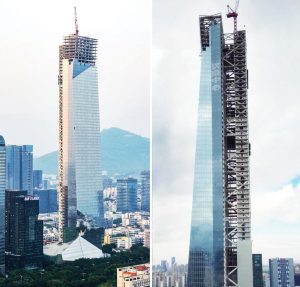WSP was an Award winner for its Hanking Center project in the 2017 Annual Excellence in Structural Engineering Awards Program in the Category – New Buildings over $100M.
The Hanking Center in Shenzhen is China’s tallest steel-framed structure, rising 70 stories and 1,140 feet, with over 1,000,000 square feet of office space above six levels of retail. Tour an office floor and you will find a wide-open space with views in all four directions, but you will not find a restroom or an elevator lobby. That is unless you cross a narrow bridge spanning the 35 feet back to the service core, which is a separate 68-story, 1,110-foot tower.
By separating the building services from the office space, architects at Morphosis created a more open office layout while maximizing daylight and views from office and circulation areas alike. But acting separately, the two towers would have been far too slender to resist wind and seismic overturning forces effectively. The resulting challenge was to structurally link the two towers, taking advantage of their larger, combined footprint without compromising the visual separation that is so critical to the architectural form.
Complicating matters further, the design wind loads in Shenzhen are more than twice as large as in typical inland areas of China. Located along China’s southern coast, Shenzhen has a warm, tropical climate similar to that of Miami. And like Miami, Shenzhen’s wind loads are controlled by hurricanes – or typhoons as they are called in Asia. For the Hanking Center, 100-year wind pressures exceed 100 psf at the top of the building, and the resulting factored wind overturning forces were comparable to the overturning forces from a 2,500-year seismic event.
The unique architecture and high wind loads invited a creative structural solution. Designers at WSP in Chicago – formerly Halvorson and Partners – devised a mega-braced tube structural system in which rectangular concrete filled tube (RCFT) steel columns along the combined building perimeter are linked with built-up steel box-shaped diagonal braces, maximizing overturning resistance against broad-face wind loads. The mega-bracing, arranged on a four-story module, is complemented by secondary bracing around stair and elevator cores which is arranged on a one-story module. Further linkage was achieved by providing outrigger and belt trusses at three of the five mechanical levels.
Although several initial structural concepts were developed with reinforced concrete shear walls instead of steel bracing, it was soon determined that the primarily steel mega-braced scheme would be the optimal choice for the Hanking Center. In addition to allowing for more transparency and a clearer visual separation between the two towers, the applicable Chinese codes allowed the steel scheme a more favorable interstory drift limit (H/250) than would be allowed for a concrete (H/500) or composite structure (H/400).
With the larger interstory drift limit, enough material reductions were possible that the primarily steel scheme was estimated to be roughly equal cost or even slightly cheaper than the competing concrete wall schemes. However, the applicability of the H/250 drift limit for a scheme with RCFT columns had to be agreed upon by the Expert Panel Review Board, which is composed of leading professionals and academics in China and has the authority to approve the design or block the project from moving forward. WSP demonstrated that even under relatively large wind displacements, the mega-braced tube system effectively minimizes shear distortion, which is the type of deformation associated with damage to cladding, partitions, or other non-structural elements. This is because the bracing arrangement links all the columns together such that the entire tower deforms primarily in bending rather than shear, so plane sections remain essentially planar. Ultimately, the expert panel agreed to allow the H/250 drift limit, confirming one of the main advantages of the steel structural system.
To ensure that the two towers behave dynamically as a single structure, two sets of W14x159 diaphragm x-braces are placed at every fourth floor, matching the module of the mega-bracing. These diaphragm braces were designed to resist a variety of special load conditions, including unequal wind pressures on each side of the tower, and to remain elastic even under a 2,500-year earthquake. Also, a comparison of modal analysis results demonstrated that the diaphragm braces are sufficiently stiff so that lateral and torsional mode shapes are essentially the same as they would be if fully rigid diaphragms were assumed to exist on each floor.
Less than eight months after beginning work on the schematic design, WSP presented structural drawings, along with a comprehensive analysis and design report, to the Expert Panel in Shenzhen. The report included a review of system irregularities, special requirements for “critical” elements (including the braces holding the two towers together), nonlinear time history analysis under 2,500-year earthquake loads, construction sequence analysis, progressive collapse resistance, and finite element analysis of the mega-brace connection nodes. Following the presentation, the Hanking Center was approved by the Expert Panel. Steel erection topped out in early 2017, and the building will open in 2018.▪
